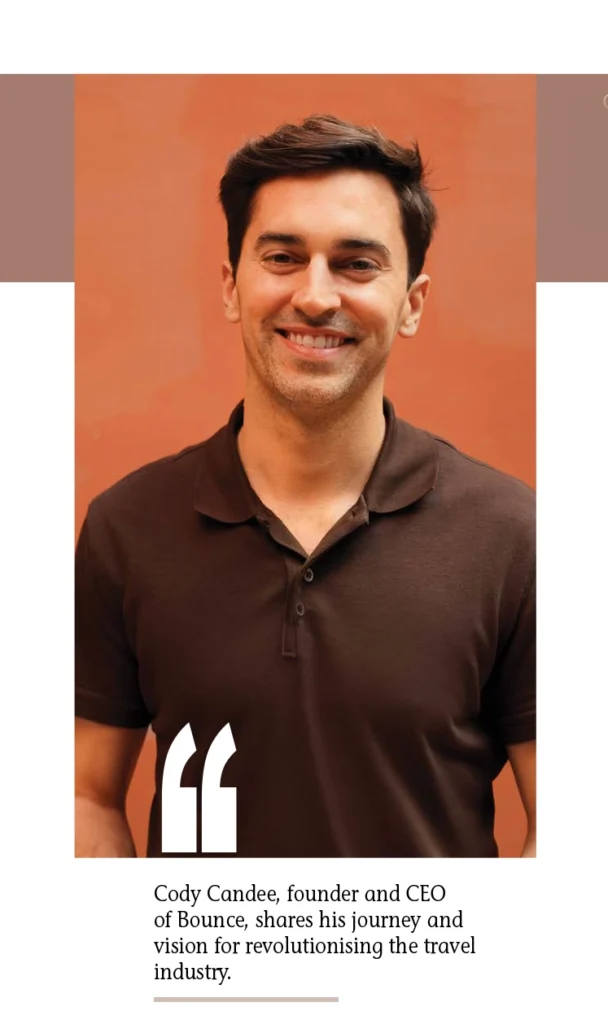Cody Candee, founder and CEO of Bounce, shares his journey and vision for revolutionising the travel industry.
Cody Candee, the dynamic founder and CEO of the travel tech start-up Bounce, is no stranger to innovation and entrepreneurship. With a background that includes a pivotal role as Product Lead at Intuit and the co-founding of several start-ups, Cody’s journey is a testament to his relentless drive to create impactful solutions. Holding a BA from the University of Wisconsin-Madison, Cody has leveraged his academic foundation and professional experiences to build Bounce into a thriving enterprise.
In this exclusive interview, Cody shares the inspiration behind Bounce, a service designed to liberate people from the burden of their belongings, allowing them to fully embrace life’s experiences. He delves into the strategic decision to expand Bounce’s operations to Europe, the challenges and triumphs encountered along the way, and the critical pivots that have shaped the company’s trajectory. Cody also offers invaluable insights into building a cohesive, global team and provides sage advice for entrepreneurs aiming to scale their start-ups and conquer international markets.
Join us as we explore Cody Candee’s entrepreneurial journey, the evolution of Bounce, and his vision for the future of on-demand solutions.
Can you share your career journey and what led you to create Bounce?
I have always felt a strong pull towards building something of my own. The idea for Bounce came to me while I was working as a Product Manager at Intuit. One evening when a group of us were headed to after-work drinks, one of my colleagues decided they would have to go all the way home to drop their bags before heading back into the city to meet us. I thought there’s got to be a better solution. At that moment, the idea for Bounce was born. What if we could build a solution that allowed people to be free to live life to the full, rather than having to miss out on experiences because of their belongings.
What motivated you to relocate Bounce from the US to Europe, and what were the biggest challenges you faced during this transition?
It wasn’t so much a full relocation as it was the opening of some of our functions such as Engineering, Product and Operations out of Lisbon. This was a strategic decision driven by several factors. Portugal has a fast-growing start-up scene, offering incentives and support to help tech companies thrive, plus its home to many exceptionally talented people in the functions we wanted to build out. As a start-up in the travel space, Europe also has a high density of urban centres and a vibrant travel market, making it an ideal location for our services.

One of the challenges when we began opening Bounce in Europe was building a network of local partners and storage locations from scratch, as it meant a lot of relationship building and finding opportunities in markets that we were less familiar with at the time. However, these efforts have paid off, and we’ve seen tremendous growth and massive growth of Bounce in the European market. In the last 24 months we saw a 20x growth in revenue, and Europe is a huge part of that.
Bounce has pivoted several times. Can you walk us through some of these pivots and the rationale behind them?
Pivoting has been an essential part of Bounce’s journey. The original idea for Bounce was to make it easier to summon things away from you and back to you, with both storage points and delivery drivers to move your stuff around. Based on our early observations and market feedback, what we decided right from the start was to partner with local businesses, such as hotels, cafes, and retail stores, to offer storage solutions instead. This approach allowed us to scale rapidly without the need for physical infrastructure. It also provided local businesses with an additional revenue stream, creating a win-win situation.
Another pivot came during the COVID-19 pandemic when travel ground to a halt. Before COVID, we’d focused primarily on growing our presence in the US market, but once the pandemic hit we realized we would need to pivot to be able to build supply wherever demand was still available. This flexibility helped us open up new market opportunities, such as Europe.
Each pivot we’ve made has been driven by a combination of market feedback, strategic opportunities, and the need to adapt to changing circumstances. Staying flexible and responsive to market needs has been crucial to our success.
What are your long-term goals for Bounce, and how do you plan to achieve them?
Our long-term goals for Bounce are ambitious but grounded in a clear vision. We aim to become the go-to platform for on-demand solutions globally. This involves not only expanding our geographical footprint but also diversifying our service offerings to meet a broader range of needs.
What strategies have you found most effective for building and retaining a strong team across different continents?
Building and retaining a strong team across different continents requires a blend of clear communication, cultural sensitivity, and a shared vision. Here are some strategies that have worked for us:
• Clear Communication: Regular communication is key. We use tools like Slack and video chat to keep everyone connected and ensure that all team members, regardless of location, are aligned with our goals and updates. We also have bi-annual company trips so that the team can spend time together and align on projects in person.
• Transparency: As well as clear communication, to keep people engaged and give them a sense of purpose it’s paramount to be as open and transparent as possible with the team.
• Shared Vision: Having a clear and compelling mission that resonates with everyone in the company helps in uniting the team. We ensure that every team member understands how their work contributes to our overall mission.
• Empower decision-making: Everyone on the team is empowered to owns the outcome of their projects. This helps everyone to make decisions quickly helps in addressing any challenges we face effectively.
What advice would you give to entrepreneurs who are looking to scale their startups and navigate international markets?
Scaling a start-up and navigating international markets is daunting but rewarding. Here’s my advice to fellow entrepreneurs:
• Understand local markets and stay agile: Get to know the local market dynamics and customer behaviours. Tailor your approach to fit the local context where necessary. Flexibility and responsiveness are key to thriving in new markets
• Build a Strong Network: Establishing local partnerships and a network of contacts can provide valuable insights and support.
• Maintain a Unified Culture: As you expand, maintaining a strong and unified company culture becomes challenging but essential. Ensure that your core values and mission are communicated clearly and embraced by all team members, regardless of location.
• Focus on Quality: While scaling, don’t compromise on the quality of your product or service. Consistent quality builds trust and credibility in new markets.
Navigating international markets is a journey filled with learning and growth opportunities. Embrace the challenges, stay focused on your mission, and continually adapt to new environments to achieve sustainable growth.






























